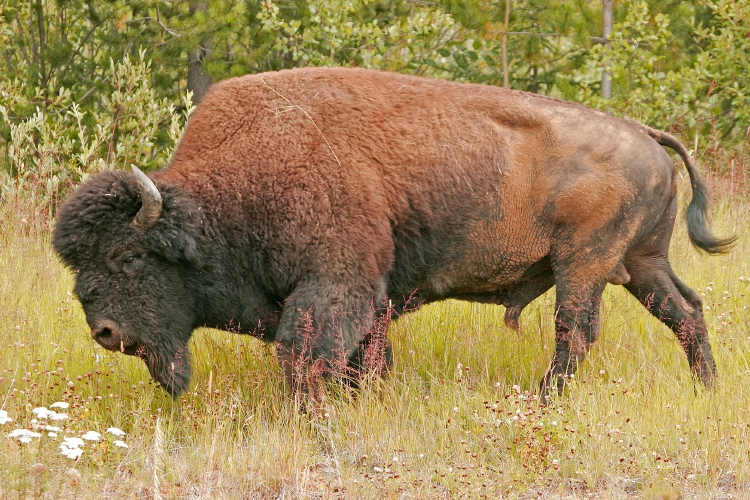- Wood Bison
image_caption = Wood Bison
regnum =Animal ia
phylum = Chordata
classis =Mammal ia
ordo =Artiodactyla
familia =Bovidae
subfamilia =Bovinae
genus = "Bison "
species = "B. bison"
subspecies = "B. bison athabascae"
trinomial = "Bison bison athabascae"
trinomial_authority = Rhoads, 1897The Wood Bison or Wood Buffalothe words "" and "" are often used interchangeably in popular parlance; however, the scientific name for this North American
bovine is "bison".] ("Bison bison athabascae") is a distinct northernsubspecies of the North American Bison. Its original range included much of the boreal forest regions ofAlaska ,Yukon , westernNorthwest Territories , northeasternBritish Columbia , northernAlberta , and northwesternSaskatchewan . It is included on the Committee on the Status of Endangered Wildlife in Canada (COSEWIC) Threatened species list.Morphology
The Wood Bison differs from the
Plains Bison ("Bison bison bison"), the other surviving North American subspecies, in a number of important ways. Most notably, the Wood Bison is heavier, with large males weighing over 900 kilograms (approximately 2000 lbs), making it the largest terrestrial animal in North America. The highest point of the Wood Bison is well ahead of its front legs, while the Plains Bison's highest point is directly above the front legs.Conservation
Reduced by
hunting from a total population of about 168,000 to less than 250 individuals by the year 1900, the Wood Bison was believed to be extinct by about 1940.A herd of about 200 was discovered in
Alberta, Canada in 1957, and has since recovered to a total population of approximately 3,536, largely as a result of conservation efforts by Canadian government agencies. In 1988, the Committee on the Status of Endangered Wildlife in Canada (COSEWIC) changed the subspecies' conservation status from "endangered" to "threatened". A subsequent reevaluation by COSEWIC in 2000 confirmed the status of "threatened".In the United States, small herds ("n"≈15) of wood bison are also located in the Alaska Wildlife Conservation Center. It is a private non-profit facility about 45 minutes south of Anchorage, Alaska on the Seward Highway.
The wood bison can also be found in "Pleistocene Park", Siberia ("n"≈30), as well as in several zoos and private game ranches.
Diseases
Publicly-owned free-ranging herds in Alberta, British Columbia, Yukon, and the Northwest Territories comprise 90% of existing Wood Bison, although six smaller public and private captive breeding herds with conservation objectives comprise approximately 10% of the total ("n"≈900). These captive herds and two large isolated free-ranging herds in the Yukon and Northwest Territories all derive from disease-free and morphologically representative founding stock from northern
Wood Buffalo National Park in northeastern Alberta and southern Northwest Territories. These captive herds are particularly important for conservation and recovery purposes, because the larger free-ranging herds in and around Wood Buffalo National Park were infected with bovinebrucellosis andtuberculosis after 7,000Plains Bison ("Bison bison bison") were trans-shipped by barge fromBuffalo National Park (Wainwright, Alberta) to Wood Buffalo National Park by the federal government during the 1920s.This trans-shipment of Plains Bison also resulted in the hybridization of all known wood bison (i.e., there are no longer any "genetically pure" Wood Bisonclarifyme).
Brucellosis andtuberculosis remainendemic in the free-ranging herds in and around Wood Buffalo National Park. The diseases represent a serious management issue for governments, various local Aboriginal groups, and thecattle industry (which is rapidly encroaching on the Park's boundaries). Disease management strategies and initiatives began in the 1950s, and have yet to result in a reduction of the incidence of either disease despite considerable expenditure and increased public involvement.Footnotes
External links
* [http://www.speciesatrisk.gc.ca/search/speciesDetails_e.cfm?SpeciesID=143 Environment Canada's Species at Risk website profiles the Wood Bison]
* [http://www.naturespicsonline.com/Nature7/index.htm Photo gallery]
* [http://alaska.org/girdwood/alaska-wildlife-conservation-center.jsp Alaska.org]
Wikimedia Foundation. 2010.

